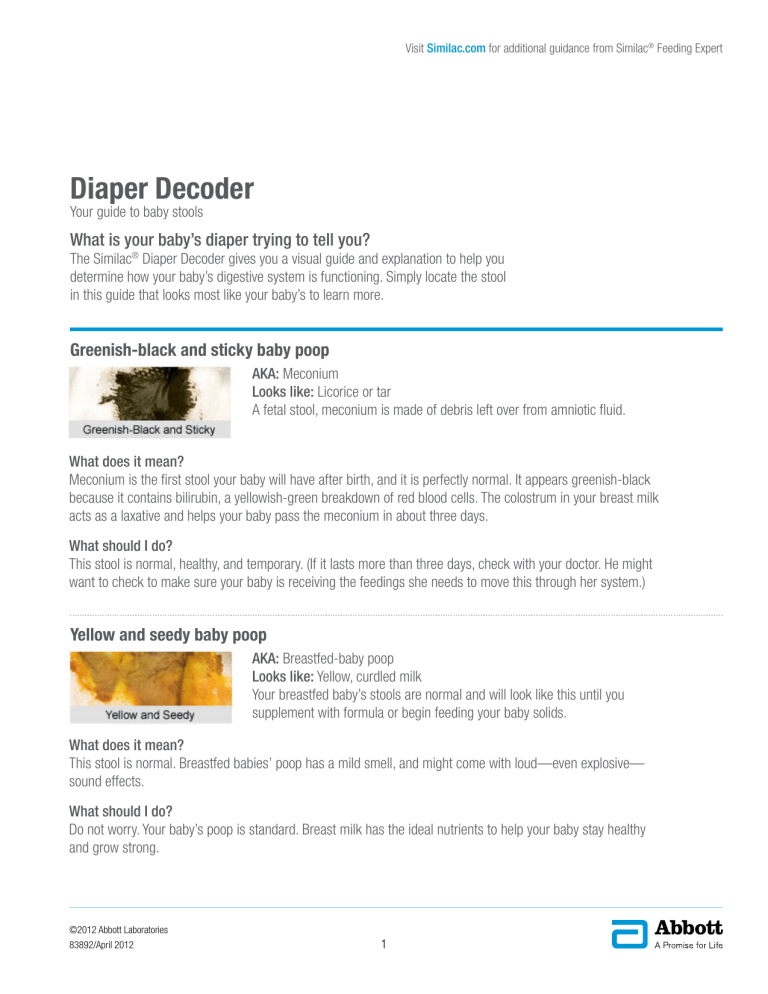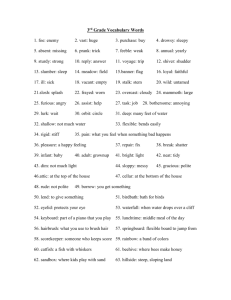Diaper Decoder - NightNurseNation

Visit Similac.com
for additional guidance from Similac ® Feeding Expert
Diaper Decoder
Your guide to baby stools
What is your baby’s diaper trying to tell you?
The Similac ® Diaper Decoder gives you a visual guide and explanation to help you determine how your baby’s digestive system is functioning. Simply locate the stool in this guide that looks most like your baby’s to learn more.
Greenish-black and sticky baby poop
AKA: Meconium
Looks like: Licorice or tar
A fetal stool, meconium is made of debris left over from amniotic fluid.
What does it mean?
Meconium is the first stool your baby will have after birth, and it is perfectly normal. It appears greenish-black because it contains bilirubin, a yellowish-green breakdown of red blood cells. The colostrum in your breast milk acts as a laxative and helps your baby pass the meconium in about three days.
What should I do?
This stool is normal, healthy, and temporary. (If it lasts more than three days, check with your doctor. He might want to check to make sure your baby is receiving the feedings she needs to move this through her system.)
Yellow and seedy baby poop
AKA: Breastfed-baby poop
Looks like: Yellow, curdled milk
Your breastfed baby’s stools are normal and will look like this until you supplement with formula or begin feeding your baby solids.
What does it mean?
This stool is normal. Breastfed babies’ poop has a mild smell, and might come with loud—even explosive— sound effects.
What should I do?
Do not worry. Your baby’s poop is standard. Breast milk has the ideal nutrients to help your baby stay healthy and grow strong.
©2012 Abbott Laboratories
83892/April 2012 1
Visit Similac.com
for additional guidance from Similac ® Feeding Expert
Tan and thick baby poop
AKA: Formula-fed-baby poop
Looks like: Hummus
This is the by-product of formula, either as a baby’s full diet or as a supplement to breast milk.
What does it mean?
Your baby’s stools are normal. You should only be concerned if your baby’s poop becomes hard (especially small hard balls of stool) or is watery.
What should I do?
There is no need to worry. Your baby’s stool is normal and healthy.
Greenish-brown baby poop
AKA: Introduction-to-solids baby poop
Looks like: Leftover guacamole
A mix of table foods, this baby poop is normal.
What does it mean?
While it is typical to see greenish-brown poop when your baby starts eating solids, you might see this color in your baby’s diaper before then. The color of this baby stool is usually normal, but if your baby has other symptoms that concern you, contact your health care professional.
What should I do?
There is no need to worry. Your baby’s stool is normal and healthy.
Pinkish-red baby poop
AKA: Artificially colored stools
Looks like: Partially digested food
What your baby eats comes out looking much the same as when it went in.
What does it mean?
Once your baby has started on solids, you will see bowel movements that can vary in color and texture after every meal. In addition to foods, some medications also can turn a baby’s poop unusual colors.
What should I do?
Watch what your baby eats to ensure there is a link between the color of the stool and what she is eating.
Examples of foods known for turning baby poop shocking colors include carrots (orange) and spinach (green).
If your baby’s stool is red for no apparent reason (no cherry Popsicle ® , Froot Loops ® cereal, or red gelatin), call your health care provider.
©2012 Abbott Laboratories
83892/April 2012 2
Visit Similac.com
for additional guidance from Similac ® Feeding Expert
Dark green baby poop
AKA: Iron supplementation
Looks like: Thick, dark stool
If your baby’s stool is dark green, it could be the product of iron supplementation in your baby’s diet.
What does it mean?
In some babies, the iron sulfate in a supplement or iron-fortified baby formula can make stools dark green, or sometimes even greenish-black. There is no need to be concerned with the color change, as it has no significance to your baby’s digestive system.
What should I do?
This stool is normal. Studies show that iron supplementation does not cause digestive problems or discomfort.
Bright green baby poop
AKA: Foremilk/hindmilk imbalance
Looks like: Green, frothy poop
Breastfed babies who receive more foremilk than hindmilk sometimes have bright green poop.
What does it mean?
When your breastfed baby nurses for short periods of time on each breast, he might get more foremilk, which is sweeter and thinner, and less hindmilk, which is richer and fattier. Your baby might need to nurse longer on each side in order to ensure enough hindmilk is consumed during each feeding. Sometimes a virus will turn your baby’s stools bright green. If your baby is fussy and seems uncomfortable, contact your health care provider.
What should I do?
Try to let your baby empty the first breast before you switch to the other side.
©2012 Abbott Laboratories
83892/April 2012 3
Visit Similac.com
for additional guidance from Similac ® Feeding Expert
Dry, brown, and hard baby poop
AKA: Constipation
Looks like: Dirt, clay, or pebbles
Hard, pellet-like stools could mean your baby is constipated.
What does it mean?
Occasional constipation is normal, especially with formula-fed babies, and when your baby transitions to solid foods. It could be a sign that your baby is not getting enough fluid or that he is losing too much fluid from the heat, illness, or a fever. Occasional blood streaking on the surface of the stool can result when hard stools make tiny tears in the soft tissues around the anus.
What should I do?
For constipation in a very young baby, consult your health care professional, who might recommend giving your baby small amounts of extra water. Give older babies plenty to drink. Consider adding 1 to 2 ounces of prune or pear juice to your baby’s diet. If your baby is eating solids, offer foods that are higher in fiber, such as fruit, vegetables, and whole grains, and add puréed prunes to your baby’s cereal. Check with your baby’s doctor about altering your baby’s diet or using juices.
Watery, brown, and loose baby poop
AKA: Diarrhea
Looks like: Watery with chunks
Frequent, loud, and loose stools could be diarrhea.
What does it mean?
The occasional loose baby stool is no cause for alarm. But if it occurs regularly for two days or more, it could be diarrhea. Diarrhea in babies can cause dehydration , and also might be a sign of infection. Usually these infections are not dangerous, but the dehydration that can result from losing too much fluid in these stools is a concern.
What should I do?
Call your health care provider if the problem persists for more than two days. The younger the baby, and the more frequent the diarrhea, the greater the concern for dehydration. Do not give your baby anti-diarrhea medication unless advised by your health care professional.
Your health care provider might advise giving your baby an oral electrolyte solution, such as Pedialyte ® , to help prevent dehydration.
©2012 Abbott Laboratories
83892/April 2012 4
Visit Similac.com
for additional guidance from Similac ® Feeding Expert
Red-streaked baby poop
AKA: Bloody stool
Looks like: A hard stool streaked with blood or mucus
Bright red blood on a baby stool could indicate that your baby has small tears, or rectal fissures, around the anus.
What does it mean?
Often the stools of constipated babies are streaked with red from rectal fissures, small cracks in the anus caused by pushing. You also might see streaks of mucus on the baby poop.
What should I do?
If your baby’s doctor confirms the bleeding is from a fissure, there is little cause for concern. Usually, once the constipation has resolved, the bleeding stops. If there is a large amount of blood (more than a few drops) or if the bleeding does not resolve with the softening of the stools, check with your doctor.
Black baby poop
AKA: Melena
Looks like: Black, thick, or tarry stool
Melena is a thick black stool that could contain blood that entered in the upper GI tract.
What does it mean?
A black baby stool might contain blood that entered the intestines in the upper portion of the digestive system.
What should I do?
If your baby has black poop that is not meconium (which passes during the first few days of life), call your health care professional immediately.
Chalky and white baby poop
AKA: Abnormal stool
Looks like: Pale, colorless, or white stool
A chalky white baby stool could be a sign of a lack of bile, which normally turns a stool brown.
What does it mean?
A white stool might be a sign of a liver or gallbladder problem. Bile is a digestive fluid made in the liver and stored in the gallbladder. Your baby’s stool gets its normal color from the bile as it is excreted during digestion. If your baby’s liver doesn’t produce bile, or if the bile is obstructed, his stool will be white.
What should I do?
A white stool is very rare, but if your baby’s poop is white, call your health care professional right away.
©2012 Abbott Laboratories
83892/April 2012 5
Visit Similac.com
for additional guidance from Similac ® Feeding Expert
Every baby reacts to feeding differently. If you continue to have questions, it’s important to contact your doctor.
Feeding Expert is also available to help.
Contact your health care professional right away for:
• Blood or mucus in stools
• Fever
• Vomiting
• Irritability
• Refusal to eat
• Decreased or dark-colored urine
• Decreased activity
The information in this guide was derived from the following:
Abbott Nutrition. Parents Guide to Infant Stools.
March 2009.
McGrail A, Metland D, Murray L, et al. The BabyCenter Essential Guide to Your Baby’s First Year.
July 2007.
Nathanson LW. The Portable Pediatrician.
September 2002.
Popsicle ® and Froot Loops ® are not registered trademarks of Abbott Laboratories.
*Lactation specialists provided by third party.
©2012 Abbott Laboratories
83892/April 2012 6







